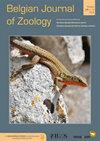两种神经系统生物之间的营养相互作用:来自贝叶斯稳定同位素数据分析工具的见解
IF 1.1
4区 生物学
Q2 ZOOLOGY
引用次数: 8
摘要
被风吹走的水手Velella Velella(林奈,1758)和它的捕食者紫蜗牛Janthina globosa(Swainson,1822)都是漂浮的neustonic生物。尽管近年来它们在全球海洋中分布,并广泛开花,但我们对这两个类群之间的猎物/捕食者相互作用的理解仍存在许多差距。利用碳和氮的稳定同位素比值,我们旨在研究V.velella和J.globosa之间的营养关系,并研究V.velilla和J.lobosa的饮食变化与个体大小的关系。贝叶斯方法被用于计算同位素生态位指标和V.velella对球形J.globosa饮食的贡献。我们的数据表明,V.velella和J.globosa的同位素生态位存在显著差异。它更大,并没有重叠的J.globosa,表明一个更可变的饮食,但在较低的营养水平比J.globoso。V.velella的同位素生态位也因个体的大小而变化。小型个体比大型动物表现出更大的同位素生态位,并且与大型个体的同位素生态位低重叠。球藻表现出非常低的同位素变异性和非常小的同位素生态位。相比之下,任何大小的球形J.globosa之间都没有同位素组成或同位素生态位差异。这种非常低的同位素变异性表明,球形J.globosa是一种专门的捕食者,至少在这种聚集中,主要以V.velella为食。此外,稳定同位素混合模型的输出显示,优先进食中型至大型(>500 mm2)的V.velella菌落。虽然我们的同位素数据显示了V.velella和J.globosa之间的营养关系,但关于这两种生物的生态学仍然存在许多问题,这表明需要对新石器生态系统进行更基础的研究。本文章由计算机程序翻译,如有差异,请以英文原文为准。
Trophic interactions between two neustonic organisms: insights from Bayesian stable isotope data analysis tools
The by-the-wind sailor Velella velella (Linnaeus, 1758) and its predator, the violet snail Janthina globosa (Swainson, 1822) are both floating neustonic organisms. Despite their global oceanic distribution and widespread blooms of V. velella in recent years, many gaps remain in our understanding about prey/predator interactions between these two taxa. Using stable isotope ratios of carbon and nitrogen, we aimed to study the trophic relationship between V. velella and J. globosa and investigate diet variation of V. velella and J. globosa in relation to individuals’ size. Bayesian approaches were used to calculate isotopic niche metrics and the contribution of V. velella to the J. globosa diet. Our data showed that the isotopic niche of V. velella differed markedly from that of J. globosa. It was larger and did not overlap that of the J. globosa, indicating a more variable diet but at a lower trophic level than J. globosa. The isotopic niche of V. velella also varied according to the size class of the individual. Small individuals showed a larger isotopic niche than larger animals and low overlap with those of the larger individuals. J. globosa displayed very low isotopic variability and very small isotopic niches. In contrast, there were no isotopic composition nor isotopic niche differences between J. globosa of any size. This very low isotopic variability suggested that J. globosa is a specialist predator, feeding, at least in this aggregation, principally on V. velella. Moreover, outputs of a stable isotope mixing model revealed preferential feeding on medium to large (> 500 mm2) V. velella colonies. While our isotopic data showed the trophic relationship between V. velella and J. globosa, many questions remain about the ecology of these two organisms, demonstrating the need for more fundamental studies about neustonic ecosystems.
求助全文
通过发布文献求助,成功后即可免费获取论文全文。
去求助
来源期刊

Belgian Journal of Zoology
生物-动物学
CiteScore
1.90
自引率
0.00%
发文量
10
审稿时长
>12 weeks
期刊介绍:
The Belgian Journal of Zoology is an open access journal publishing high-quality research papers in English that are original, of broad interest and hypothesis-driven. Manuscripts on all aspects of zoology are considered, including anatomy, behaviour, developmental biology, ecology, evolution, genetics, genomics and physiology. Manuscripts on veterinary topics are outside of the journal’s scope. The Belgian Journal of Zoology also welcomes reviews, especially from complex or poorly understood research fields in zoology. The Belgian Journal of Zoology does no longer publish purely taxonomic papers. Surveys and reports on novel or invasive animal species for Belgium are considered only if sufficient new biological or biogeographic information is included.
 求助内容:
求助内容: 应助结果提醒方式:
应助结果提醒方式:


